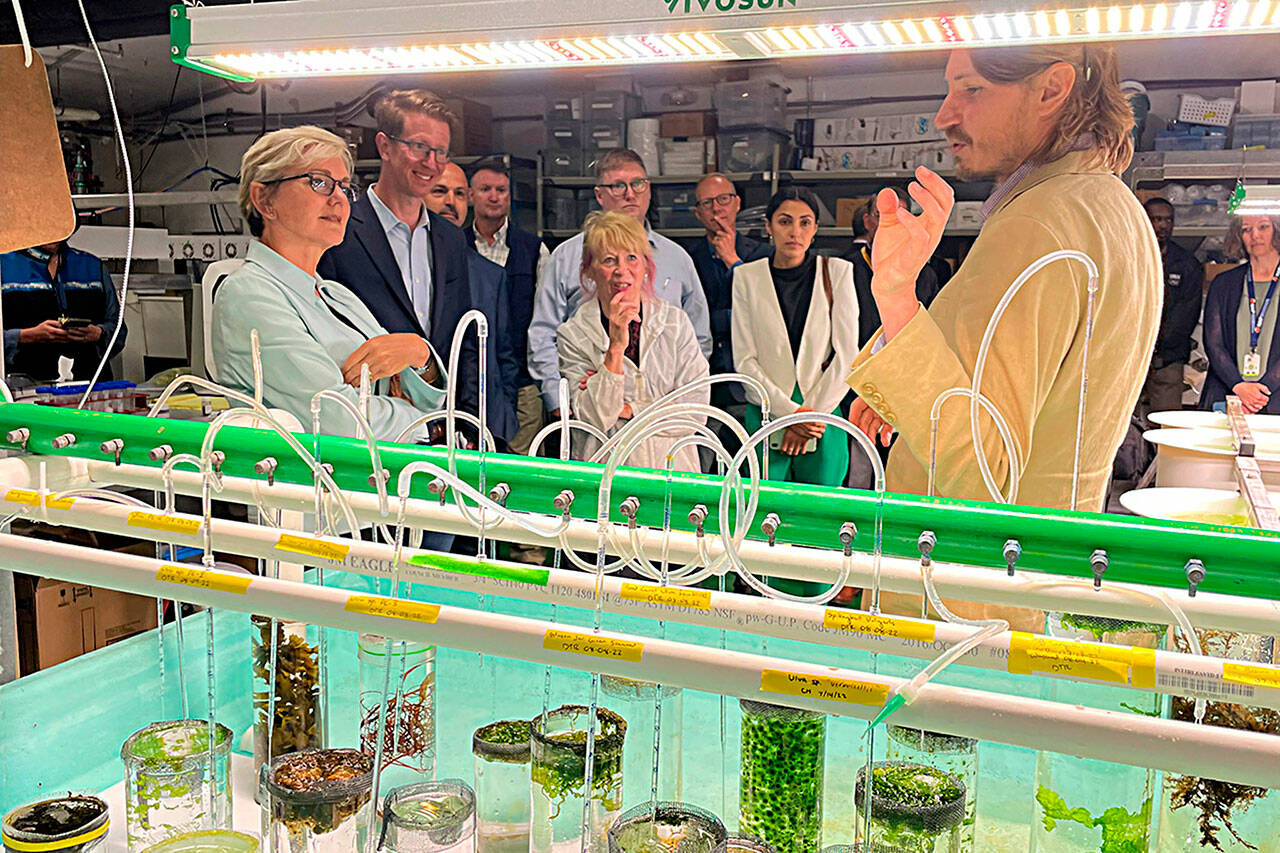For the first time in its history, Pacific Northwest National Laboratory-Sequim (PNNL-Sequim) hosted the U.S. Secretary of Energy at its campus.
Jennifer Granholm, a former governor of Michigan, came to Sequim — home of the Department of Energy’s only marine research facility — on Aug. 10 to see work related to tackling climate change, alternative energy sources and other innovations.
She and Dr. Geri Richmond, Energy’s undersecretary for Science and Innovation, went with PNNL staff in a boat ride on Sequim Bay, spoke with researchers about their clean energy efforts and met with North Olympic Peninsula stakeholders.
With the Inflation Reduction Act, and the CHIPS and Science Act tentatively investing billions into science research and development and looking to reduce carbon emissions, Granholm said this is an important moment for the United States.
“Sequim is at the center of this moment of developing an economy that is moving into (clean energy),” she said.
“The global economy for clean energy technologies and products will be $23 trillion by 2030. The Blue Economy is a $3 trillion part of that, and the question is where that’s going to be developed.”
The Blue Economy, DOE officials say, focuses on technologies and economic development of industries surrounding the ocean.
U.S. representative Derek Kilmer, who invited Granholm to see PNNL-Sequim, continues to advocate for his and Dan Newhouse’s (WA-04) bipartisan Blue Energy Innovation Act. It looks to establish a Blue Economy Center of Excellence tentatively at PNNL-Sequim to coordinate partnering agencies, and provide $75 million from DOE for research to better harness ocean energy, increase deployment of newer renewable technologies in water, drive decarbonization efforts and create jobs.
Granholm said the act would be a “holistic approach” to pushing forward the Blue Economy.
Kilmer added that PNNL-Sequim has “extraordinary capabilities” and could play a key role in looking at critical energy questions.
“There’s tremendous upside as we try to address energy security, the climate crisis, and as a guy who grew up in Clallam County, try to create more economic opportunity here on the peninsula,” Kilmer said.
He and Newhouse introduced the bill to the House of Representatives earlier this year, and it was referred to the House Committee on Science, Space and Technology.
Future, discussions
On her tour, Granholm heard researchers speak about efforts to reduce costs for offshore wind energy, reduce maintenance on machinery in the ocean, extract essential minerals from the ocean, and more.
Scott Edmundson, a PNNL-Sequim research botanist, said they’ve been able to extract 38 of 50 minerals from marine algae that the U.S. Department of the Interior deems essential for the U.S. economy.
He called it the “crop of the future” as it can grow without fresh water and fertilizer.
“We’ve only scratched the surface,” he said of algae’s capabilities.
Granholm told reporters PNNL-Sequim is a “tremendous facility” for being able to answer problems regarding climate change — “everything from the ability to test offshore wind, test tidal and marine energy, the ability to heal the ocean in terms of acidification, and the ability to enhance its ability to sequester carbon,” she said.
“We’re talking about the ability to extract critical minerals in a responsible way,” Granholm added.
Kilmer said PNNL-Sequim’s research is what people think about in relation to the nation’s energy future.
“The work happening here in Sequim is going to be central to that, which is why it’s extraordinary the secretary is here,” he said. “She and her team took time to put eyes on this and see work happening here.”
Granholm added that the Inflation Reduction Act provides incentives for the private sector to use the types of technologies being developed in Sequim.
After Sequim, Granholm traveled Aug. 11 to tour the hydropower dam in North Bend with U.S. representative Kim Schrier (WA-08), then on to PNNL-Richland with Sen. Maria Cantwell, and on Aug. 12 she was scheduled to tour the Hanford site.
On her tour of the Pacific Northwest, Granholm said it’s been “interesting to see the research side right here to the actual deployment of newer technologies to help solve the world’s bigger problems.”
Before leaving Sequim, she, Kilmer and PNNL staff met with local stakeholders about energy efforts and concerns here.
Discussions ranged from concerns about accessibility to resources due to rural location, too high of costs for alternative fuel/energy and projects, and more.
W. Ron Allen, chairman of the Jamestown S’Klallam Tribe, told Granholm “we’re all about innovation” with new energy efforts and they’d like to participate in future discussions.
“We’re here to help,” Allen said. “We just want to make sure we’re on the bench (when those decisions are made).”
Roundtable participants included: Allen; Timothy Greene, Sr., Makah Tribe chairman; Rep. Steve Tharinger (D-Port Townsend); Karen Affeld, North Olympic Development Council executive director; Meggan Uecker, City of Sequim resource analyst, and Clallam PUD general manager Sean Worthington.
PNNL-Sequim staff provided a tour for stakeholders after their meeting with Granholm.
For more information about PNNL-Sequim, visit pnnl.gov/pnnl-sequim.
For more information on the Department of Energy, visit energy.gov.


